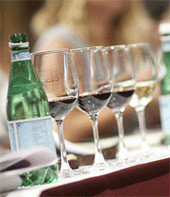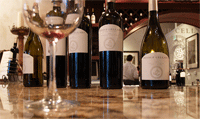Traveling to wine regions is another way of increasing skill in tasting. Many wine producers in wine regions all over the world offer tastings of their wine. Some of the larger wineries have restaurants, catering facilities and gifts shops right on the premises. Some wineries even extend the invitation for you to bring your own picnic lunch to enjoy on their grounds during your visit.

Quite a few wineries now have their own Web sites which are worth visiting ahead of time. It’s always good to double check their hours of operation as they tend to change with the season. It’s not uncommon for wineries to only allow visitors by appointment, and some wineries are not setup to host visitors at all so make sure you do your homework before setting out. Savvy Wino is a great source for finding some of these important details. Typically wineries are not child-friendly, and require all guests to be at least 21 years of age and come with proper identification. When traveling with a large group it’s always best to notify the winery or vineyard ahead of time.
White wines are typically tasted first, followed by red. Most wineries will have a sheet of tasting notes. Read the tasting notes as you taste and see if you notice any of the aromas or flavors listed in the notes. A host will provide you with tasting glasses and will take you through the process and answer any questions you might have. When in doubt, remember these three easy to do’s; look at the wine, smell the wine and taste the wine! It is not considered rude to spit out wine at a winery, even in the presence of the wine maker or owner. Generally, a spittoon will be provided. In some regions of the world, tasters simply spit on the floor or onto gravel surrounding barrels. It is polite to inquire about where to spit before beginning tasting. Also, do not feel compelled to finish the entire glass, in fact it is not expected that you will. Many winery hosts will provide you with a dump bucket for you to spill out wine you do not wish to finish. It is not considered rude to spit out wine at a winery, even in the presence of the wine maker or owner.
Depending on the country or region, tasting at the winery may incur a small charge to allow the producer to cover costs. Sometimes the fees are wavered if purchases are made. Some wineries will even let you take home a tasting glass as a nice souvenir.
Lastly, in some wine regions such as
Napa Valley and
Washington’s Walla Walla, you will find strings of wineries, called wine trails, close enough together that you can tour a few of them in one day. If you do plan on visiting multiple wineries in one day, or can’t secure a designated driver, look into local limo or car services to take you around. You might also find a local tour company that can set this up for you.

About wine tasting
Wine tasting (often, in wine circles, simply tasting) is the sensory examination and evaluation of wine. While the practice of wine tasting is as ancient as its production, a more formalized methodology has slowly become established from the 14th century onwards. Modern, professional wine tasters (such as sommeliers or buyers for retailers) use a constantly-evolving formal terminology which is used to describe the range of perceived flavors, aromas and general characteristics of a wine.
Vertical and horizontal tasting - Vertical and horizontal wine tastings are wine tasting events that are arranged to highlight differences between similar wines. In a vertical tasting, different vintages of the same wine type from the same winery are tasted. This emphasizes differences between various vintages. In a horizontal tasting, the wines are all from the same vintage but are from different wineries. Keeping wine variety or type and wine region the same helps emphasize differences in winery styles.
Tasting flights - Tasting flight is a term used by wine tasters to describe a selection of wines, usually between three and eight glasses, but sometimes as many as fifty, presented for the purpose of sampling and comparison.
The wine tasting process
There are five basic steps in tasting wine: color, swirl, smell, taste, and savour. This is also known as the five Ss: See, Swirl, Sniff, Sip, Savor. During this process, a taster must look for clarity, varietal character, integration, expressiveness, complexity, and connectedness.
A wine's color is better judged by putting it against a white background. The wine glass is put at an angle in order to see the colors. Colors can give the taster clues to the grape variety, and whether the wine was aged in wood.
Varietal character describes how much a wine presents its inherent grape aromas. A wine taster also looks for integration, which is a state in which none of the components of the wine (acid, tannin, alcohol, etc) is out of balance with the other components. When a wine is well balanced, the wine is said to have achieved a harmonious fusion.
Another important quality of the wine to look for is its expressiveness. Expressiveness is the quality the "wine possesses when its aromas and flavors are well-defined and clearly projected. The complexity of the wine is affected by many factors, one of which may be the multiplicity of its flavors. The connectedness of the wine, a rather abstract and difficult to ascertain quality, is how connected the bond between the wine and the land where it comes from is.
A wine's quality can be judged by its bouquet and taste. The bouquet is the total aromatic experience of the wine. Assessing a wine's bouquet can also reveal faults such as cork taint, oxidation due to age, overexposure to oxygen, or lack of preservatives and wild yeast contamination due to Brettanomyces or acetobacter yeasts. Although low levels of Brettanomyces aromatic characteristics can be a positive attribute, giving the wine a distinctive character, generally it is considered a wine spoilage yeast. The bouquet of wine is best revealed by gently swirling the wine in a wine glass to expose it to more oxygen and release more aromatic etheric, ester, and aldehyde molecules that comprise the essential components of a wine's bouquet.
Pausing to experience a wine's bouquet aids the wine taster in anticipating the wine's flavors. The "nose" of a wine - its bouquet or aroma - is the major determinate of perceived flavor in the mouth. Once inside the mouth, the aromatics are further liberated by exposure to body heat, and transferred retronasally to the olfactory receptor site. It is here that the complex taste experience characteristic of a wine actually commences.
Thoroughly tasting a wine involves perception of its array of taste and mouthfeel attributes, which involve the combination of textures, flavors, weight, and overall "structure". Following appreciation of its olfactory characteristics, the wine taster savors a wine by holding it in the mouth for a few seconds to saturate the taste buds. By pursing ones lips and breathing through that small opening oxygen will pass over the wine and release even more esters. When the wine is allowed to pass slowly through the mouth it presents the connoisseur with the fullest gustatory profile available to the human palate.
The acts of pausing and focusing through each step distinguishes wine tasting from simple quaffing. Through this process, the full array of aromatic molecules is captured and interpreted by approximately 15 million olfactory receptors, comprising a few hundred olfactory receptor classes. When tasting several wines in succession, however, key aspects of this fuller experience (length and finish, or aftertaste) must necessarily be sacrificed through expectoration. Although taste qualities are known to be widely distributed throughout the oral cavity, the concept of an anatomical "tongue map" yet persists in the wine tasting arena, in which different tastes are believed to map to different areas of the tongue. A widely accepted example is the misperception that the tip of the tongue uniquely tells how sweet a wine is and the upper edges tell its acidity.